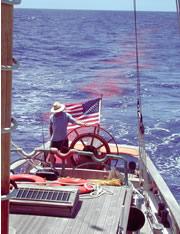 Throwing iron in the ocean doesn't necessarily make much algae bloom.Planktos Foundation
Throwing iron in the ocean doesn't necessarily make much algae bloom.Planktos FoundationBlooms of algae created by pumping nutrients into the ocean can suck up at least ten times more carbon dioxide (CO2) from the atmosphere than was previously thought. But the findings lend no support to controversial schemes to encourage such blooms in order to reduce global warming, the authors warn.
The conclusion comes from a survey of a large, annually recurring natural algal bloom near Kerguelen, an archipelago halfway between South Africa and Australia. Natural vertical mixing of the ocean there steadily supplies iron and other nutrients from sediments at the ocean floor to the surface waters, encouraging phytoplankton growth. This growth converts carbon in the air (as CO2) to organic matter, thus reducing the amount of greenhouse gas in the atmosphere and alleviating climate warming.
Stephane Blain, a chemical oceanographer at the Oceanography and Biogeochemistry Laboratory in Marseille, France, led a 47-strong international team to investigate this bloom in detail in early 2005. Their results show that the ability of such blooms to suck up CO2, and to carry that carbon to the ocean floor when the organisms die, is much greater than previous field studies had suggested.
“Geo-engineering the ocean won't work.”
Ulf Riebezell
IFM-GEOMAR
Each atom of iron supplied from below pulled more than 100,000 atoms of carbon out of the atmosphere by stimulating plankton growth during the seasonal bloom, they report in Nature1.
In 12 previous experiments carried out since 1993, during which scientists had artificially 'fertilized' small patches of ocean with iron nutrient, the observed amount of carbon exported to the deep ocean per amount of iron supplied had been around one magnitude lower2.
Dumping at sea
Lack of iron limits biological productivity and CO2 uptake in one-third of the world ocean, and particularly so in the Southern Ocean.
Scientists have long proposed that 'seeding' such oceans with extra iron could provide an eco-friendly means of reducing CO2 in the atmosphere; this notion spurred the many experiments in which researchers tried adding iron to small patches of sea.
Aside from the worries associated with 'geo-engineering' and the knock-on effects this might have on the ecosystem, these experiments were plagued with logistical problems.
Often iron isn't the only nutrient missing from the water, and much of the iron dumped into the sea oxidizes before it can be used by phytoplankton. An estimated 80-95% of the iron in these experiments has been 'lost', often because it simply drifts away or sinks to the deep ocean before organisms near the surface are able to make use of it. Researchers estimate that dumping huge amounts of iron into large swaths of the sea would absorb no more than 3% of annual CO2 emissions from fossil-fuel burning.
Nature does best
ADVERTISEMENT
Blain's study shows that mother nature can do much better at fertilizing the ocean than mankind. The rate at which CO2 is sucked up seems to be so great at Kerguelen because the iron is being supplied slowly and continuously, and because the ecosystem is rich in other biological and chemical ingredients needed for such a bloom.
"What the team has observed is probably the optimal efficiency of carbon export achievable," says Ulf Riebesell, a biological oceanographer at the Leibniz Institute of Marine Sciences (IFM-GEOMAR) in Kiel, Germany, who has been involved in one previous ocean fertilization experiment. "You just can't achieve nature's efficiency," he adds. "That's why geo-engineering the ocean won't work."
The results also provide valuable information for studies of past and future climate change. It has long been thought that an increased flow of iron-rich dust from dry areas on land during cold times can caused atmospheric CO2 to plummet. The new study supports the idea that this effect has contributed to around one-third of the atmospheric CO2 drop during past glacial climates.
Visit our mothernatureknowshow_t.html">newsblog to read and post comments about this story.
IFM-GEOMAR
-
References
- Blain S., et al. Nature, 446. 1070 - 1074 (2007). | Article |
- Boyd P., et al. Science, 315. 612 - 617 (2007).
